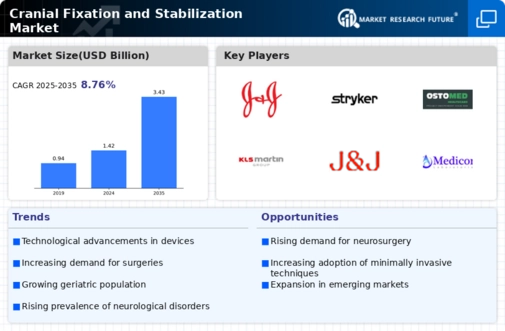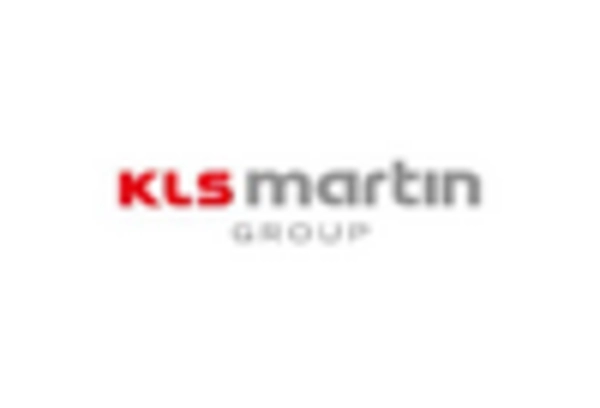-
Market Introduction
-
Definition
-
Scope of the Study
- Assumptions
- Limitations
-
2.2.1
-
Research Objective
-
Chapter
-
Research Methodology
-
Introduction
-
Primary Research
-
3.3
-
Secondary research
-
Market Size Estimation
-
Chapter 4. Market Dynamics
-
Drivers
-
Restrains
-
Opportunities
-
Challenges
-
Chapter 5. Market Factor Analysis
-
Porters Five Forces Analysis
- Bargaining Power of Buyers
- Threat of Substitutes
- Intensity of
-
5.1.1
-
Bargaining Power of Suppliers
-
5.1.3
-
Threat of New Entrants
-
Rivalry
-
Value Chain Analysis
-
Chapter 6. Global Cranial Fixation &
-
Stabilization Market, by Category
-
Introduction
-
Cranial Fixation
-
Systems
-
Cranial Stabilization Systems
-
Chapter 7. Global Cranial Fixation
-
& Stabilization Market, by Product
-
Introduction
-
Meshes
-
Skull Clamps
-
Flap Tube Clamps
-
Horseshoe Headrests
-
7.6
-
Plates
-
Screws
-
Accessories
-
Chapter 8. Global Cranial Fixation
-
& Stabilization Market, by Type
-
Introduction
-
Resorbable
-
Non-Resorbable
-
Chapter 9. Global Cranial Fixation & Stabilization
-
Market, by End User
-
Introduction
-
Hospitals
-
Ambulatory
-
Surgical Centers
-
Others
-
Chapter 10. Global Cranial Fixation &
-
Stabilization Market, by Region
-
Introduction
-
Americas
-
10.2.1
-
North America
-
Europe
-
10.4.2
-
China
-
10.4.6
-
Rest of Asia-Pacific
-
10.5.2
-
Saudi Arabia
-
of the Middle East & Africa
-
Chapter 11. Competitive Landscape
-
11.1
-
Introduction
-
Strategies
-
Chapter 12 Company Profiles
-
12.1
-
Johnson & Johnson
-
12.2.2
-
Financial Overview
-
12.3.1
-
Company Overview
-
Corporation
-
12.6.3
-
Products Offered
-
12.6.6
-
Key Strategies
-
Offered
-
Strategies
-
Overview
-
12.9.5
-
SWOT Analysis
-
Overview
-
12.10.4
-
Key Developments
-
12.11
-
Jeil Medical
-
12.12.2
-
Financial Overview
-
12.13.1
-
Company Overview
-
Developments
-
12.16
-
Zimmer Biomet
-
Chapter 13. Appendix
-
13.1.
-
References
-
US
-
Canada
-
Latin America
-
Europe
- Western Europe
- Eastern Europe
-
Asia-Pacific
- Japan
- India
- Australia
- South Korea
-
Middle East & Africa
- UAE
- Oman
- Kuwait
- Qatar
- Rest
-
Market Share Analysis
-
Key Developments &
- Key Developments
- Company Overview
- Financial Overview
- Products Offered
- Key Developments
- SWOT Analysis
- Key Strategies
-
Stryker
- Company Overview
- Products Offered
- Key Developments
- SWOT Analysis
- Key Strategies
-
Ostomed
- Financial Overview
- Products Offered
- Key Developments
- SWOT Analysis
- Key Strategies
-
KLS Martin Group
- Company Overview
- Financial Overview
- Products Offered
- Key Developments
- SWOT Analysis
- Key Strategies
-
Medtronic
- Company Overview
- Financial Overview
- Products Offered
- Key Developments
- SWOT Analysis
- Key Strategies
-
Integra LifeSciences
- Company Overview
- Financial Overview
- Key Developments
- SWOT Analysis
-
B. Braun Melsungen AG
- Company Overview
- Financial Overview
- Products Offered
- Key Developments
- SWOT Analysis
- Key Strategies
-
Changzhou Huida
- Company Overview
- Financial Overview
- Products
- Key Developments
- SWOT Analysis
- Key
-
DePuy Synthes
- Company Overview
- Financial
- Products Offered
- Key Developments
- Key Strategies
-
Evonos
- Company
- Financial Overview
- Products Offered
- SWOT Analysis
- Key Strategies
- Company Overview
- Financial Overview
- Products Offered
- Key Developments
- SWOT Analysis
- Key Strategies
-
Medicon
- Company Overview
- Products Offered
- Key Developments
- SWOT Analysis
- Key Strategies
-
Micromar
- Financial Overview
- Products Offered
- Key Developments
- SWOT Analysis
- Key Strategies
-
NEOS Surgery
- Company Overview
- Financial Overview
- Products Offered
- Key Developments
- SWOT Analysis
- Key Strategies
-
Pro Med Instruments
- Company Overview
- Financial Overview
- Products Offered
- Key
- SWOT Analysis
- Key Strategies
- Company Overview
- Financial Overview
- Products Offered
- Key Developments
- SWOT Analysis
- Key Strategies
-
Others
-
Related Reports
-
LIST OF TABLES
-
Table
-
Global Cranial Fixation & Stabilization Synopsis, 2020-2027
-
Global
-
Cranial Fixation & Stabilization Market Estimates & Forecast, 2020-2027,
-
(USD Million)
-
Global Cranial Fixation & Stabilization Market, by
-
Region 2020-2027, (USD Million)
-
Global Cranial Fixation & Stabilization
-
Market, by Category 2020-2027, (USD Million)
-
Global Cranial Fixation
-
& Stabilization Market, by Product 2020-2027, (USD Million)
-
Global
-
Cranial Fixation & Stabilization Market, by Type 2020-2027, (USD Million)
-
Global Cranial Fixation & Stabilization Market, by End User 2020-2027,
-
(USD Million)
-
Americas: Cranial Fixation & Stabilization Market,
-
by Category 2020-2027, (USD Million)
-
Americas: Cranial Fixation &
-
Stabilization Market, by Product 2020-2027, (USD Million)
-
Americas:
-
Cranial Fixation & Stabilization Market, by Type 2020-2027, (USD Million)
-
Americas: Cranial Fixation & Stabilization Market, by End User 2020-2027,
-
(USD Million)
-
North America: Cranial Fixation & Stabilization
-
Market, by Category 2020-2027, (USD Million)
-
North America: Cranial
-
Fixation & Stabilization Market, by Product 2020-2027, (USD Million)
-
Table
-
North America: Cranial Fixation & Stabilization Market, by Type 2020-2027,
-
(USD Million)
-
North America: Cranial Fixation & Stabilization
-
Market, by End User 2020-2027, (USD Million)
-
Latin America: Cranial
-
Fixation & Stabilization Market, by Category 2020-2027, (USD Million)
-
Table
-
Latin America: Cranial Fixation & Stabilization Market, by Product 2020-2027,
-
(USD Million)
-
Latin America: Cranial Fixation & Stabilization
-
Market, by Type 2020-2027, (USD Million)
-
Latin America: Cranial Fixation
-
& Stabilization Market, by End User 2020-2027, (USD Million)
-
Europe:
-
Cranial Fixation & Stabilization Market, by Category 2020-2027, (USD Million)
-
Europe: Cranial Fixation & Stabilization Market, by Product 2020-2027,
-
(USD Million)
-
Europe: Cranial Fixation & Stabilization Market,
-
by Type 2020-2027, (USD Million)
-
Europe: Cranial Fixation & Stabilization
-
Market, by End User 2020-2027, (USD Million)
-
Western Europe: Cranial
-
Fixation & Stabilization Market, by Category 2020-2027, (USD Million)
-
Table
-
Western Europe: Cranial Fixation & Stabilization Market, by Product 2020-2027,
-
(USD Million)
-
Western Europe: Cranial Fixation & Stabilization
-
Market, by Type 2020-2027, (USD Million)
-
Western Europe: Cranial Fixation
-
& Stabilization Market, by End User 2020-2027, (USD Million)
-
Eastern
-
Europe: Cranial Fixation & Stabilization Market, by Category 2020-2027, (USD
-
Million)
-
Eastern Europe: Cranial Fixation & Stabilization Market,
-
by Product 2020-2027, (USD Million)
-
Eastern Europe: Cranial Fixation
-
& Stabilization Market, by Type 2020-2027, (USD Million)
-
Eastern
-
Europe: Cranial Fixation & Stabilization Market, by End User 2020-2027, (USD
-
Million)
-
Asia-Pacific: Cranial Fixation & Stabilization Market,
-
by Category 2020-2027, (USD Million)
-
Asia-Pacific: Cranial Fixation
-
& Stabilization Market, by Product 2020-2027, (USD Million)
-
Asia-Pacific:
-
Cranial Fixation & Stabilization Market, by Type 2020-2027, (USD Million)
-
Asia-Pacific: Cranial Fixation & Stabilization Market, by End User
-
Middle East & Africa: Cranial Fixation
-
& Stabilization Market, by Category 2020-2027, (USD Million)
-
Middle
-
East & Africa: Cranial Fixation & Stabilization Market, by Product 2020-2027,
-
(USD Million)
-
Middle East & Africa: Cranial Fixation & Stabilization
-
Market, by Type 2020-2027, (USD Million)
-
Middle East & Africa:
-
Cranial Fixation & Stabilization Market, by End User 2020-2027, (USD Million)
-
LIST OF FIGURES
-
Research Process
-
Segmentation
-
of the Global Cranial Fixation & Stabilization Market
-
Market Dynamics
-
for the Global Cranial Fixation & Stabilization Market
-
Global
-
Cranial Fixation & Stabilization Market Share, by Category, 2020
-
Figure
-
Global Cranial Fixation & Stabilization Market Share, by Product, 2020
-
Global Cranial Fixation & Stabilization Market Share, by Type, 2020
-
Global Cranial Fixation & Stabilization Market Share, by End User,
-
Global Cranial Fixation & Stabilization Market Share, by
-
Region, 2020
-
Americas: Cranial Fixation & Stabilization Market
-
Share, by Region, 2020
-
North America: Cranial Fixation & Stabilization
-
Market Share, by Country, 2020
-
Latin America: Cranial Fixation &
-
Stabilization Market Share, by Country, 2020
-
Europe: Cranial Fixation
-
& Stabilization Market Share, by Country, 2020
-
Asia-Pacific:
-
Cranial Fixation & Stabilization Market Share, by Country, 2020
-
Figure
-
Middle East & Africa: Cranial Fixation & Stabilization Market Share,
-
by Country, 2020
-
Global Cranial Fixation & Stabilization Market:
-
Company Share Analysis, 2020 (%)
-
Johnson & Johnson: Key Financials
-
Johnson & Johnson: Segmental Revenue
-
Johnson &
-
Johnson: Regional Revenue
-
Stryker: Key Financials
-
Figure 20
-
Stryker: Segmental Revenue
-
Stryker: Regional Revenue
-
Figure
-
Ostomed: Key Financials
-
Ostomed: Segmental Revenue
-
Figure
-
Ostomed: Regional Revenue
-
KLS Martin Group: Key Financials
-
KLS Martin Group: Segmental Revenue
-
KLS Martin Group:
-
Regional Revenue
-
Medtronic: Key Financials
-
Medtronic:
-
Segmental Revenue
-
Medtronic: Regional Revenue
-
Integra
-
LifeSciences Corporation: Key Financials
-
Integra LifeSciences Corporation:
-
Regional Revenue
-
Integra LifeSciences Corporation: Key Financials
-
B. Braun Melsungen AG: Segmental Revenue
-
B. Braun Melsungen
-
AG: Regional Revenue
-
B. Braun Melsungen AG: Key Financials
-
Figure
-
Changzhou Huida: Segmental Revenue
-
Changzhou Huida: Regional Revenue
-
Changzhou Huida: Key Financials
-
DePuy Synthes: Segmental
-
Revenue
-
DePuy Synthes: Regional Revenue
-
DePuy Synthes:
-
Key Financials
-
Evonos: Segmental Revenue
-
Evonos: Regional
-
Revenue
-
Evonos: Key Financials
-
Jeil Medical: Segmental
-
Revenue
-
Jeil Medical: Regional Revenue
-
Jeil Medical:
-
Key Financials
-
Medicon: Segmental Revenue
-
Medicon:
-
Regional Revenue
-
Medicon: Key Financials
-
Micromar:
-
Segmental Revenue
-
Micromar: Regional Revenue
-
Micromar:
-
Key Financials
-
NEOS Surgery: Segmental Revenue
-
NEOS
-
Surgery: Regional Revenue
-
NEOS Surgery: Key Financials
-
Figure
-
Pro Med Instruments: Segmental Revenue
-
Pro Med Instruments: Regional
-
Revenue
-
Pro Med Instruments: Key Financials
-
Zimmer
-
Biomet: Segmental Revenue
-
Zimmer Biomet: Regional Revenue
-
Figure
-
Zimmer Biomet: Key Financials










Leave a Comment